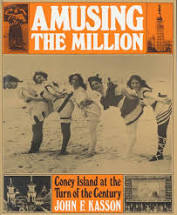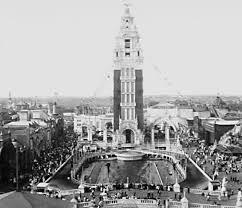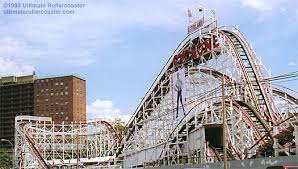Favorites Places, Different Time
Studying history can be a delightful exercise in disciplined imagination. It requires us to summon forth in our minds – critically, with data and evidence – what happened in a different time in a different place. More than assembling sources and crafting arguments, fully immersed historical study is transcendent. It whisks us away while we stay at home.

I took such a trip to one of my favorite places when I read John Kasson’s 1978 history monograph, Amusing the Million: Coney Island at the Turn of the Century. I don’t know how many years ago, probably decades, that I first encountered this slim and well-written study. It is a smartly crafted work that cast a long shadow in the study of popular culture. Kasson’s writing is accessible and scholarly, good with details and theory. He is a reliable and caring guide.
Coney Island, for the uninitiated, was the nation’s first mass amusement area. A Brooklyn beach-side resort in the 1800s, Coney Island grew rapidly in the latter quarter of that century. Accessible and affordable, Coney Island sat at the intersection of New York City’s massive population growth, the rise of the middle and working classes with disposable income, and the creation of mass production entertainment. It offered opportunity for socialization, pleasure and wonder within a short train ride of the city’s apartments and tenements. It was and remains to this day a special place, close to the city, of the city, and apart from the city.

Kasson situates Coney Island’s development within the broader historical context of the New York City’s Central Park, created after the Civil War, and the 1893 Colombian Exposition in Chicago, one of the most important cultural events of the latter half of the century. He explains what trends the entrepreneurs in Coney Island followed and where they established their own paths. Sensitive to issues of race, ethnicity and gender, Kasson recounts how Coney Island represented an alternative cultural space for its millions of visitors.

As one of those regular visitors – I’ve riding the Cyclone and Wonder Wheel annually for decades – the book truly comes to life when it goes into detail describing the ambitious amusement parks built in the years before the first World War. Steeplechase Park, Luna Park and Dreamland, each in their own way, created immersive alternative realities for day-tripping New Yorkers. Fantastic architecture, cutting-edge technologies, and shows designed to amuse, entertain and amaze shaped these extraordinary spaces. The photos alone can transport me.
When casting about for a read in these challenging times, consider dipping into well-written history. And if you pick up a copy of Kasson’s Amusing the Million, I’m sure that you’ll find it engaging.
David Potash